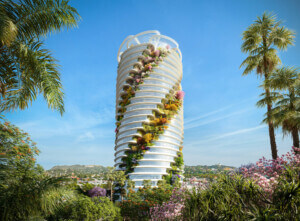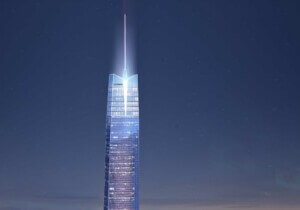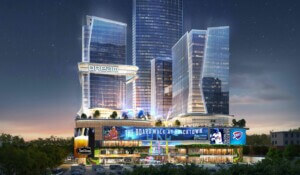PBS’s four-part TV series, Super Skyscrapers, deals with uber-high buildings around the world. It is rare to follow the process of constructing a building, let alone a monster-sized one. Yet here, a special characteristic of each of the four skyscrapers is highlighted within the context of maximum height: One World Trade Center’s safety measures, Leadenhall’s prefabrication, One57’s high luxury, and Shanghai Tower’s vertical city aspirations.
Interestingly, the architects’ roles in the buildings is downplayed. We do meet SOM’s David Childs, who tells us about the shape of One World Trade; glimpse Graham Stirk of Rogers Stirk Harbour who tells us Leadenhall’s triangular form solved a mandate of not blocking the view of St. Paul’s Cathedral; and we see some of the Gensler team behind the Shanghai Tower. However, the name Christian de Portzamparc is not once uttered in the One57 episode.
One World Trade Center, New York
The series begins with One World Trade Center during the final year of construction as it climbs to its 1,776 foot height. There are breathtaking shots from the very top of the structure looking down the building to the streets below, the water’s edge, and New York City traffic. Another view catapults up a very long elevator shaft.
The history of the design process is bypassed except for mention of a global competition that produced some “wild ideas” (over a shot of Daniel Libeskind)—“but then a real plan evolved.” The program emphasized that after 9/11, the new World Trade Center had to be “the safest and strongest in the world,” protected from explosions, storms, earthquakes, and any other catastrophe, natural or man-made. The building’s concrete core is much tougher than pre-9/11 buildings, with the life support systems embedded in “the world’s tallest bunker.” Safety features include wider stairs so people could rush both up and down simultaneously, filters to purify air in stairwells to protect against biological or chemical attack, pressurized stairwells to keep smoke from entering when doors open, and luminous tape in stairwells (like in an airplane) to show the way without lights.
A highlight of this episode is seeing the “spire” erected (it’s called a spire instead of an antenna so that the top counts towards the building’s measured height). Made in Quebec, the spire’s 18 pieces—weighing 40 tons—are first seen on a barge sailing in New York Harbor past the Statue of Liberty. Once ashore, they travel by night through city streets in a slow processional before being hoisting by a 1,400-foot-tall vertical crane-lift, the tallest in the United States.
Footage from the top of the tower is thrilling. The lighting will be like an old-fashioned lighthouse with 288 LEDs for a horizontal beam of light visible for 15 miles. Hundreds more LEDs on the exterior of the spire can change colors and create vivid patterns. The construction is also a contradiction of advanced technology and the archaic—some of the fastest elevators in the world running up to 2,000 feet per minute, alongside metalworkers welding, hammering, and screwing bolts like in a Lewis Hine photograph from the 1930s.
Leadenhall Building, London
Like a giant Lego set, the Leadenhall Building in the heart of the City of London is a pre-fabricated skyscraper with a perimeter-braced diagrid exoskeleton put up by 1/3 the standard-sized crew. This 48-story structure nicknamed the “Cheese Grater” is appetizingly close to Foster’s Gherkin. A two-year construction period is lightening speed for a building in the heart of a major capital. The tower’s tapering triangular shape together with the placement of all core functions—elevator, bathrooms, mechanical, and electrical systems—in a separate but connected, stand-alone tower on the north side permit unobstructed views of St. Paul’s Cathedral.
The majority of construction took place in the north of England and northern Ireland, including the 90-foot-long, steel mega-columns—all 11,000 of them—which are simply bolted into place on arrival. On each floor are three modular structures called “tables” (four columns joined by the floor structure) which are fully loaded with guts inside (plumbing, electrical, HVAC) and will be visible since they are sprayed a bright yellow. Only 24 bolts are used to secure the modules—no welding, no concrete required.
Pre-cast concrete floors are fixed to the “tables” and installed by six workers and one crane driver (pouring on site would have taken three times as long and used double the manpower). The pre-fab installation process was enabled by 3D computer models made by “digital engineers” who plotted out the sequences in 15-minute intervals in advance.
One57
This episode is all about money and time. One57 will be the tallest residential tower in the western hemisphere with a 30-story hotel and 94 residential condos including two 10,000-square-foot penthouses. The Central Park views are its calling card, and there is much time spent on the interiors—the just-right Carrara marble for the bathrooms, custom wood kitchens made in Wiltshire, England, and advertising photographs of the aerial views taken from miniature drone helicopters. We meet former diamond dealer, Gary Barnett, President of Extell Development, but not the tower’s architect, Christian de Portzamparc. The Skyscraper Museum’s Carol Willis quoted Cass Gilbert: “A skyscraper is a machine that makes the land pay.”
Shanghai Tower
Set in Pudong, Shanghai, where the near-future was depicted in the movie Her, the newest addition to cluster of the nearby super-towers, Shanghai World Financial Center and Jin Mao Tower, Shanghai Tower will be the second tallest building in the world at 2,073 feet (second only to the Burj Khalifa in Dubai). In fact, Pudong now has double the number of skyscrapers as New York.
Understanding that there has been overdevelopment with resulting pollution and congestion, Gensler counters by saying Shanghai Tower will be an island, a vertical city. The skyscraper will house 30,000 people on 121 floors split into 9 “districts.” To demonstrate the city concept, a model of the tower is shown on its side, making an analogy with city blocks (although one city block in Pudong is the equivalent of six in lower Manhattan).
There are actually two curtain walls with an “atrium” or “sky garden” in between, much like a thermos. These perimeter gardens have internal air currents which will actually power wind turbines at the very top. These two curtain walls are hung around the same core, like a skyscraper wrapped around another skyscraper.
The building was constructed from the top down using a ring-beam structure nicknamed the “Flying Saucer,” rather than the bottom up, so it’s like a hanging garden. To minimize effects of severe winds, the corners were rounded, and torqued to shift to 120 degrees as the building rises — the more it twists, the more the reduction of wind.
Super Skyscrapers
“One World Trade Center”
“Building the Future” Leadenhall
“The Vertical City” Shanghai Tower, airdate 2/19/14
“The Billionaire Building” One57, airdate 2/26/14
Super Skyscrapers is broadcast on Wednesdays on PBS. The series is half-way through the broadcast run on PBS, however all episodes can be viewed in their entirety online.










